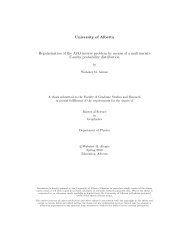Soner Bekleric Title of Thesis: Nonlinear Prediction via Volterra Ser
Soner Bekleric Title of Thesis: Nonlinear Prediction via Volterra Ser
Soner Bekleric Title of Thesis: Nonlinear Prediction via Volterra Ser
You also want an ePaper? Increase the reach of your titles
YUMPU automatically turns print PDFs into web optimized ePapers that Google loves.
2.3. LINEAR PREDICTION 10<br />
E(z) 1<br />
X(z)<br />
A(z)<br />
Figure 2.1: AR IIR filter representation. After Makhoul (1975) and Ulrych and<br />
Sacchi (2005).<br />
2.3 Linear <strong>Prediction</strong><br />
The relationship between input/output for a linear time -invariant system is given<br />
by the classical convolution integral (Rugh, 1981; Oppenheim and Schafer, 1989;<br />
Schetzen, 2006),<br />
y(n) =<br />
∞<br />
−∞<br />
h(σ)x(n − σ)dσ . (2.8)<br />
In the last expression h(σ) is the impulse response <strong>of</strong> the system or kernel function<br />
that defines the input x(n) /output y(n) <strong>of</strong> the system.<br />
Equation 2.8 is <strong>of</strong>ten used in the discrete form. The convolution integral is<br />
replaced by a convolution sum and signals are replaced by a finite length discrete<br />
time series:<br />
yn =<br />
N<br />
aixn−i . (2.9)<br />
i=1<br />
The latter is the discrete convolution sum that arises very frequently in geophysics<br />
and other sciences. It basically relates the output <strong>of</strong> a system that is excited with<br />
an input signal xn <strong>via</strong> the convolution <strong>of</strong> the signal with the impulse response <strong>of</strong><br />
the system, in this case called an.<br />
In linear prediction theory, one attempts to predict a signal by its past values<br />
(or future values) by replacing the output signal yn by a future (one step ahead)









